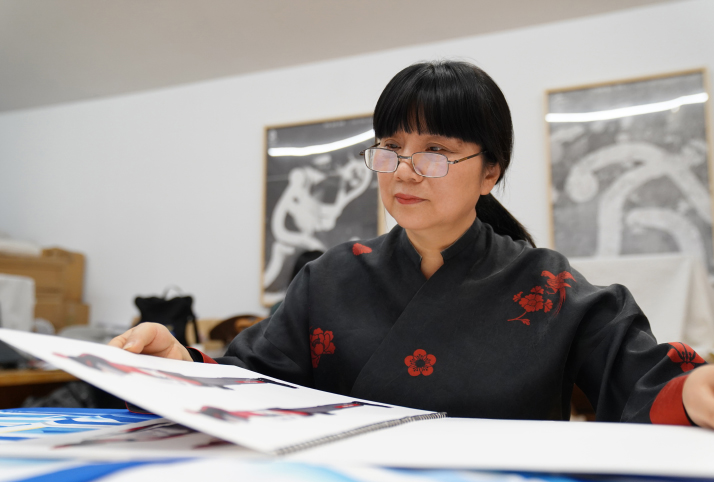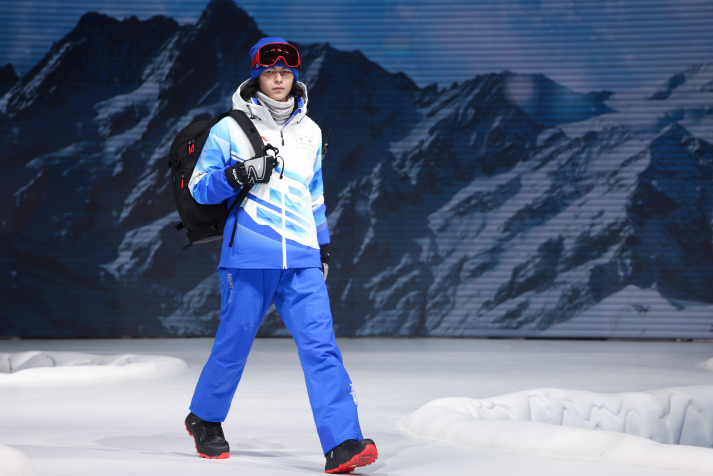| Latest News |
| Innovation and tradition are woven through uniforms for the Beijing 2022 Games | |
| From 2008 to 2022, the main design principles of the Olympic uniforms have stitched up the decade-plus gap, portraying the pride of the dual Olympic host and heightening the national image | |
|
|
 He Yang at work inside her Beijing studio on December 24, 2021(ZHANG WEI)
At the mere mention of color, generally springs to mind the seven-tone rainbow spectrum. Color plays a prominent role in China, both in language and aesthetics. Incorporating Chinese hues and their cultural essence into the uniforms for the Olympic and Paralympic Winter Games Beijing 2022 is crucial to He Yang, designer of this edition's official gear. The palette and patterns together cleverly line the uniforms and lift their cultural meaning, she believes, reflecting the nation's traditional aesthetic consciousness. The Beijing Organizing Committee for the 2022 Olympic and Paralympic Winter Games (BOCOG) unveiled its official attire on October 27, 2021, on the occasion of the 100-day countdown to the Beijing 2022 Games. Three main colors are featured in these uniforms. Red is for staff, blue for volunteers, and gray is the main color for technical officials. Winter Olympic garb is more difficult to design, given that in addition to looking good, it has to keep the wearer warm. Connecting elements of the Beijing 2022 Games core graphics with traditional Chinese landscape painting techniques, the clothes, shoes and accessories all express the harmonious coexistence of humanity and nature.  A model presents the uniform for volunteers of the Beijing 2022 Games on October 27, 2021 (VCG)
He is the mastermind behind the uniforms. A professor with Beijing Institute of Fashion Technology, she was also in charge of the Beijing 2008 outfit designs. Palette of principles The color scheme for the Beijing 2022 Games uniforms bears distinct local features. "For example, hong means red. But xiaguang hong, the (literally) glowing red color of the staff and technical official uniforms, loses most of its poetic conjecture if it is simply translated as 'red'," He told Beijing Review. "But if a child is brought up in a Chinese context, like in Beijing, they know perfectly well that the abbreviation stems from the rising or setting sun in urban wintertime, radiating enthusiasm and hope. "Here, the red color is cleverly used with poetic words to 'narrate' the context and 'paint' the image," He added. She said the uniform, a window display of Chinese culture, features simple yet cheerful characteristics. According to He, red and grey tops with black trousers are inspired by the highest ceremonial colors of ancient times. The sapphire sky blue tones gracing the volunteers' uniforms are the color of traditional Chinese ceramic, jilan, its blue glaze, with gem-like luster, reflecting the volunteering vitality. Flushes of snow white channel the harmonious and symbolize both the purity of snow as well as the famous Chinese proverb "ruixue zhao fengnian," meaning "timely snowfall promises a year with good harvests." One of the principal considerations throughout the design process was the uniform should display the time-honored Chinese cultural character in an intelligible and identifiable way, He said. "We had to strike a balance between cultural representation, etiquette and the spirit of young Chinese athletes." Not the easiest of feats. As the visual principles of the Olympic uniforms had already been stipulated in terms of styles, standard colors, and basic patterns, how much room could be left for innovation? Yet from He's perspective, this was a non-issue. The design was selected from more than 600 entries and subsequently optimized over the course of eight rounds. "Everyone used the same elements, but the outcomes were very different," He said. To certain extent, the restrictions clarified the general direction. "We had to seek innovation and breakthroughs within the restrictions," she added. Wisdom of non-waste He's understanding is related to her long-term engagement in the research on Chinese ethnic costumes. As curator of the National Costume Museum under Beijing Institute of Fashion Technology, she deems the variety in traditional costumes nationwide related to restrictions. "The limitations of regions, materials, and local craftsmanship have created unique styles of clothing in various places," she said. The limitations themselves do not hinder innovation. By giving full rein to personal talent within the confines, we can forge recognizable revolution." For He, a good design starts from the general "less is more" concept. This means to apply elements sparingly, gaining the most effects through the fewest features. Like a red thread, this notion also runs through the BOCOG uniform designs for the Beijing 2022 Games. She was once suggested to highlight more Chinese elements in her work, like pine, bamboo, plum and embroidery; but these never made the final cut. "Using techniques prudently and saving costs are all part of traditional wisdom," He said. The concepts of environmental protection and sustainability, too, have been integrated into the design, production, and distribution of the uniforms. For example, the yarn used in equipment storage bags is made from recycled plastics in line with a green, environmentally-friendly and sustainable Winter Olympics, according to Zhang Jiandong, Vice Mayor of Beijing and Executive Vice President of the BOCOG. Meanwhile, Team China's podium uniform for the Games, courtesy of Hong Kong designer Timmy Yip and inspired by the Chinese character zhong, features a stand collar and knotted buttons, both distinctive and simple. "The red line in the middle stands for the central axis of China's capital of Beijing, meaning the host city gathers together international friends, echoing the official motto of the Winter Olympics, 'Together for a Shared Future'," Yip said. A tale of two Olympics According to He, Beijing's 2008/2022 Olympic legacy is important to showcase that the capital is the first-ever city to dually host Summer and Winter Olympics in the 120-year-long history of the modern Games. "China's confidence soared between the two Olympics, and the international environment has become very different over the 14 years following the Olympic Summer Games Beijing 2008," He said. "In the past, we tried to emphasize and present our culture to the world as much as possible, but today, there is no longer this need for emphasis, because the world has become aware." The 2008 Games marked a symbolic moment for China, with the theme song Beijing Welcomes You telling the world about this reinvented and reinvigorated country. From 2008 to 2022, the main design principles of the Olympic uniforms have stitched up the decade-plus gap, portraying the pride of the dual Olympic host and heightening the national image. Natural beauty is inherent to Chinese traditional costumes, according to He. The image of the snow-capped mountains in the core graphics of the Beijing 2022 Games reflect the transcendent pursuit of natural beauty; they communicate the symphony between man and nature as well as the concept of a green Olympics. "China can build up its cultural image with the help of big international events like the Winter Olympics," He concluded. "A uniform's design has to articulate a modern take on fashion and the Chinese spirit alike." Printed edition title:The Red Thread of Olympic Fate Comments to taozihui@cicgamericas.com |
|
||||||||||||||||||||||||||||||
|